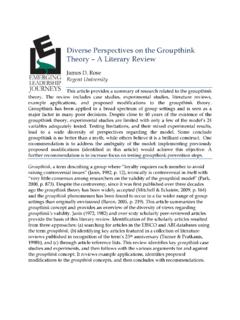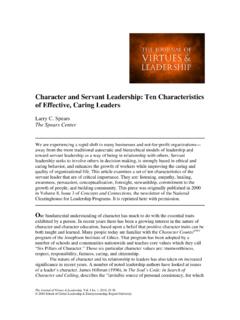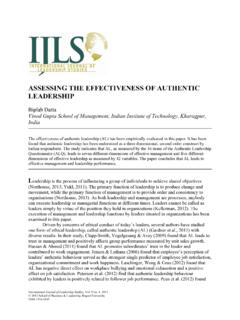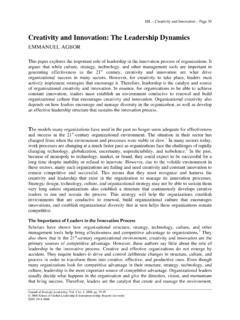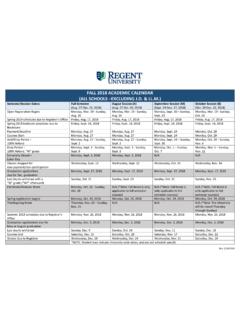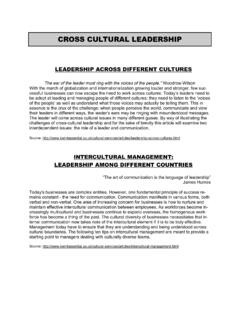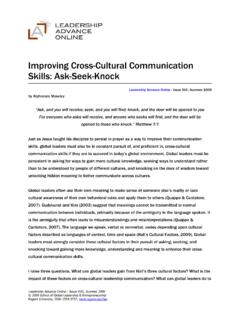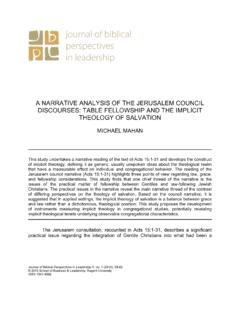Transcription of The Understanding and Practice of Servant- …
1 REGENT UNIVERSITY The Understanding and Practice of Servant- Leadership Servant Leadership Research Roundtable August 2005 Larry C. Spears President & CEO The Greenleaf Center for Servant- Leadership The Servant- leader is servant first. It begins with the natural feeling that one wants to serve. Then conscious choice brings one to aspire to lead. The best test is: do those served grow as persons; do they, while being served, become healthier, wiser, freer, more autonomous, more likely themselves to become servants? Robert K. Greenleaf The mightiest of rivers are first fed by many small trickles of water, and an apt way of conveying my belief that the growing number of individuals and organizations practicing Servant- leadership has increased from a trickle to a river.
2 Servant- leadership is also an expanding river, and one which carries with it a deep current of meaning and passion. The Servant- leader concept continues to grow in its influence and impact. In fact, we have witnessed an unparalleled explosion of interest and Practice of Servant- leadership in the past fifteen years. In many ways, it can truly be said that the times are only now beginning to catch up with Robert Greenleaf s visionary call to Servant- leadership. The idea of Servant- leadership, now in its fourth decade as a concept bearing that name, continues to create a quiet revolution in workplaces around the world. This article is intended to provide a broad overview of the growing influence this inspiring idea is having on people and their workplaces. In countless for-profit and not-for-profit organizations today we are seeing traditional, autocratic, and hierarchical modes of leadership yielding to a different way of working one based on teamwork and community, one that seeks to involve others in decision making, one strongly based in ethical and caring behavior, and one that is attempting to enhance the personal growth of workers while improving the caring and quality of our many institutions.
3 This emerging approach to leadership and service is called Servant- leadership. The words servant and leader are usually thought of as being opposites. When two opposites are brought together in a creative and meaningful way, a paradox emerges. And so the words servant and leader have been brought together to create the paradoxical idea of Servant- leadership. The basic idea of Servant- leadership is both logical and intuitive. Since the time of the industrial revolution, managers have tended to view people as objects; institutions have considered workers as cogs within a machine. In the past few decades we have witnessed a shift in that long-held view. Standard practices are rapidly shifting toward the ideas put forward by Robert Greenleaf, Stephen Covey, Peter Senge, Max DePree, Margaret Wheatley, Ken Blanchard, and many others who suggest that there is a better way to lead and manage our organizations.
4 2 The Understanding and Practice of Servant- Leadership - Spears Robert Greenleaf s writings on the subject of Servant- leadership helped to get this movement started, and his views have had a profound and growing effect on many. Robert K. Greenleaf Despite all the buzz about modern leadership techniques, no one knows better than Greenleaf what really matters. Working Woman magazine The term Servant- leadership was first coined in a 1970 essay by Robert K. Greenleaf (1904-1990), entitled The Servant as Leader. Greenleaf, born in Terre Haute, Indiana, spent most of his organizational life in the field of management research, development, and education at AT&T. Following a 40-year career at AT&T, Greenleaf enjoyed a second career that lasted 25 years, during which time he served as an influential consultant to a number of major institutions, including Ohio University, MIT, Ford Foundation, K.
5 Mellon Foundation, the Mead Corporation, the American Foundation for Management Research, and Lilly Endowment Inc. In 1964 Greenleaf also founded the Center for Applied Ethics, which was renamed the Robert K. Greenleaf Center in 1985 and is now headquartered in Indianapolis. As a lifelong student of how things get done in organizations, Greenleaf distilled his observations in a series of essays and books on the theme of The Servant as Leader the objective of which was to stimulate thought and action for building a better, more caring society. The Servant as Leader Idea The idea of the servant as leader came partly out of Greenleaf s half century of experience in working to shape large institutions. However, the event that crystallized Greenleaf s thinking came in the 1960s, when he read Hermann Hesse s short novel Journey to the East an account of a mythical journey by a group of people on a spiritual quest.
6 After reading this story, Greenleaf concluded that the central meaning of it was that the great leader is first experienced as a servant to others, and that this simple fact is central to his or her greatness. True leadership emerges from those whose primary motivation is a deep desire to help others. In 1970, at the age of 66, Greenleaf published The Servant as Leader, the first of a dozen essays and books on Servant- leadership. Since that time, more than a half-million copies of his books and essays have been sold worldwide. Slowly but surely, Greenleaf s Servant- leadership writings have made a deep, lasting impression on leaders, educators, and many others who are concerned with issues of leadership, management, service, and personal growth. What is Servant- Leadership?
7 In his works, Greenleaf discusses the need for a better approach to leadership, one that puts serving others including employees, customers, and community as the number one priority. Servant- leadership emphasizes increased service to others, a holistic approach to work, promoting a sense of community, and the sharing of power in decision making. Who is a Servant- leader? Greenleaf said that the Servant- leader is one who is a servant first. In The Servant as Leader he wrote, It begins with the natural feeling that one wants to serve, to serve first. Then conscious choice brings one to aspire to lead. The difference manifests itself in the care taken by the servant first to make sure that other people s highest priority needs are being served. The best test is: Do those served grow as persons; do they, while being served, become healthier, wiser, freer, more autonomous, more likely themselves to become servants?
8 And, what is the effect on the least privileged in society? Will they benefit or at least not be further deprived? It is important to stress that Servant- leadership is not a quick-fix approach. Nor is it something that can be Servant Leadership Research Roundtable August 2005 3 Published by the School of Leadership Studies, Regent University quickly instilled within an institution. At its core, Servant- leadership is a long-term, transformational approach to life and work in essence, a way of being that has the potential for creating positive change throughout our society. Characteristics of the Servant- Leader Servant leadership deals with the reality of power in everyday life its legitimacy, the ethical restraints upon it and the beneficial results that can be attained through the appropriate use of power.
9 The New York Times After some years of carefully considering Greenleaf s original writings, I have extracted a set of 10 characteristics of the Servant- leader that I view as being of critical importance. The following characteristics are central to the development of Servant- leaders: 1. Listening: Leaders have traditionally been valued for their communication and decision-making skills. While these are also important skills for the Servant- leader, they need to be reinforced by a deep commitment to listening intently to others. The Servant- leader seeks to identify the will of a group and helps clarify that will. He or she seeks to listen receptively to what is being said (and not said!). Listening also encompasses getting in touch with one s own inner voice and seeking to understand what one s body, spirit, and mind are communicating.
10 Listening, coupled with regular periods of reflection, is essential to the growth of the Servant- leader. 2. Empathy: The Servant- leader strives to understand and empathize with others. People need to be accepted and recognized for their special and unique spirits. One assumes the good intentions of co-workers and does not reject them as people, even while refusing to accept their behavior or performance. The most successful Servant- leaders are those who have become skilled empathetic listeners. 3. Healing: Learning to heal is a powerful force for transformation and integration. One of the great strengths of Servant- leadership is the potential for healing one s self and others. Many people have broken spirits and have suffered from a variety of emotional hurts. Although this is a part of being human, Servant- leaders recognize that they have an opportunity to help make whole those with whom they come in contact.

